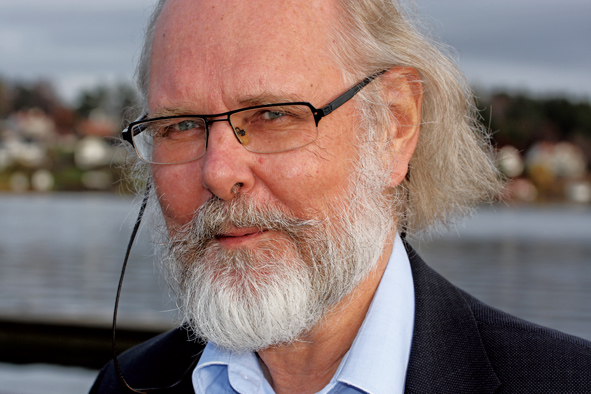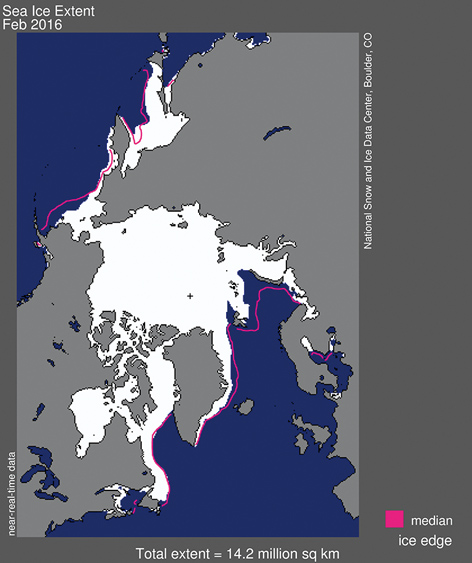By SONG Jianlan (Staff Reporter)
Global Change is affecting both the marine Arctic and Antarctic as well as the Himalayas and the broader Tibetan area – also known as “The Pan-Third Pole” due to its altitude and extreme environment – explains Prof. Nils Chr. Stenseth, former President of the Norwegian Academy of Science and Letters (DNVA) and a current Faculty Professor and Research Professor of Ecology and Evolution of the University of Oslo. A high-profile biologist long dedicated to marine ecology in the Arctic region and its evolution under global change, Prof. Stenseth is seeking to pool data and results from “The Pan-Third Pole” to solve fundamental problems pertaining to the wellbeing of people.

Prof. Nils Chr. Stenseth, former President of the Norwegian Academy of Science and Letters (DNVA) and currently a Faculty Professor and Research Professor of Ecology and Evolution of the University of Oslo (UiO). (Photo by courtesy of UiO)

The map shows the extent of the Arctic sea ice as recorded in February 2016 by the National Snow and Ice Data Center, USA, in comparison with the 1981 to 2010 median extent for the same month (indicated by the magenta line). Concerned about the impact of climatic change on the local marine ecosystem and fisheries, Nordic scientists are looking at findings from the Third Pole – the Himalayas and the neighboring Tibetan area to update their know-how of the hidden change beneath the deep water of the Barents Sea. (Image credit: The National Snow and Ice Data Center, USA)
“A Nordic View”
“Linking up with the North and South Poles is of great comparative value,” said Prof. Stenseth at his plenary lecture given at the inauguration of the Alliance of International Science Organizations (ANSO) in the Belt and Road (B&R) Region, commenting on the Pan Third Pole Environment (P-TPE) program initiated by the Chinese Academy of Sciences (CAS), an international effort to understand the geological, atmospheric and environmental processes and climatic changes of the Pan Third Pole area, as well as their interactions.
At invitation of CAS, Prof. Stenseth attended the inauguration of ANSO on behalf of The Norwegian Academy of Science and Letters (DNVA), and gave a plenary lecture at the opening session, contributing to the discussion on the prospective role of this brand-new international organization from “a Nordic view.”
Prof. Stenseth is Deputy Chair of the Board of the Nansen Legacy, a Norwegian national research program. Launched in 2018 and named after Prof. Fridtjof Nansen, founding father of modern neurology as well as oceanography, this program seeks to understand the rapidly changing marine climate and ecology of the Arctic region, particularly of the northern Barents Sea. Due to warm water from the Atlantic Ocean, this area has seen a 50% reduction in ice cover and shallower distribution of warm water – causing remarkable change in the local marine environment and hence the ecosystems, with altered distribution and composition of species. This big change makes it necessary to revise the know-how in the dynamics of the physical and biological components of the local ecosystems.
In his plenary lecture, Prof. Stenseth gave an overview of the Arctic research activities under the Nansen Legacy in cooperation with the pan Arctic countries, and expressed his strong interest in joining hands with Chinese scientists, particularly with the international team dedicated to the P-TPE program, emphasizing the great comparative value of data from Pan-Third Pole areas concerning geological, environmental and climatic changes, and beyond.

The Nansen Legacy, a Norwegian national research program, seeks to understand the rapidly changing marine climate and ecology of the Arctic region, particularly of the northern Barents Sea. Seen in the picture are researchers at field work, investigating changes in ice level of this area. (Photo by Luka Supraha, University of Oslo)
“Norway strongly supports this initiative,” he asserted.
“There is already a road connecting Norway and Russia; but we’d like to extend it to China,” anticipated Prof. Stenseth when introducing the cooperation between his country and Russia on Arctic research. “To further develop the international collaboration on the Himalaya system is in itself important, joining together research of terrestrial ecology and marine ecology to target a common grand challenge,” he explained in a talk with the author after his lecture, envisioning a global network of research covering all the “Three Poles” of the planet.

Himalayas and the Nordic Cod
Specifically, as an expert in marine ecology, he has been trying to understand what has been driving the variability of fish stock – a central question long-sought-after by Prof. Stenseth and his colleagues, focusing heavily on fishery resources.
“It is a big problem,” said Prof. Stenseth, citing multiple factors influencing the fish catch in Norwegian waters. Results from previous research arrived at the conclusion that to a large extent, the variability in fish stock is driven by the number of fish in the youngest age-class caught in fisheries. The problem is, the early life stages of a fish is hinged on the ambient conditions, including water temperature and competition of resources from other species, which are both subject to climate change. For example, combined statistical and mechanistic modelling suggests that food and temperature affect the survival of early life stages of Northeast Arctic cod (Gadus morhua) (Leif Chr. Stige, et al, 2015).
The drivers of climate change hidden deep in the Barents Sea as well as in the atmosphere of the Arctic region, however, seem to be connected with a larger pattern of change, in “teleconnection” with the icecap and glacier recession of the Himalayas.
“The P-TPE initiative, being facilitated with ANSO, can contribute a terrestrial perspective of extreme environments. The North Pole is an extreme environment; the South Pole is another extreme environment; and the Himalayas are also an extreme environment. Thus, understanding of extreme environments will be advanced on, addressing global change, a big challenge. And ANSO is a good framework for investigating that,” explained Prof. Stenseth.
“Mostly what we study is marine science. P-TPE asks different questions and answers them in different ways – in the terrestrial and in the marine – targeting the same basic issues, such as global change, the more variable climate is that affecting the marine system and the terrestrial system. And there might be some inter-connection between them. The monsoon is not operating by itself, but in a worldwide climatic system. So, if we are really able to study this extreme environment, it would be very valuable to understanding how the biological system will be affected by global change, not only with an increasing temperature, but most importantly, via bringing in variability – more extreme weather,” he said.
The most recent extreme climatic variability in the Himalayas reported by the P-TPE team sheds light on the sensitivity and vulnerability of the ecosystems to climate change. Over the past years, the temperature across this region rose twice that of the global average, with serious environmental consequences: shrinking glaciers, expanding lake water volumes and frequent floods. On the other hand, the recession of glaciers is changing the water cycle and draining the down-stream lakes and oases.

The Pan-Third Pole region extended over 20 million km2 from the Tibetan Plateau-centered Third Pole to its west and north, encompassing the Pamirs, Tibetan
Plateau, the Himalayas, the Hindu Kush, the Iranian Plateau, the Caucasus, and the Carpathians etc.
Joining Three Poles
“We are carrying out a major national research project in the Arctic. Ten institutions are involved,” introduced Prof. Stenseth. “It’s a Norwegian initiative, but we would like to link up with scientists from the rest of the world: US institutions, Chinese institutions and others. And I am very keen on seeing China to be involved.”
Prof. Stenseth is seeking to tie cooperation with the P-TPE team, headed by Prof. YAO Tandong, CAS Member and head of the CAS Institute of Tibetan Plateau Research. He has for a long time been dedicated to the research on the glacier environment of the Tibetan area and global change.
“The North Pole and the South Pole are dominated by geophysics and marine biology. The Third Pole is focused on geophysics and climate, and terrestrial ecology. Having the Third Pole in a comparative way, we really bring together terrestrial and marine science into one problem. And that’s the comparative advantage,” explained Prof. Stenseth. “That’s why I think the trio-pole program is a fantastic initiative from China.”
“We in Norway are supporting and facilitating the ring between China, the trio-pole ring of China and Europe, and international activities. I know the P-TPE initiative here has a very good scientific network, focusing on the Third Pole. We can investigate the two others where we have a strong tradition,” continued Prof. Stenseth.
According to Prof. Stenseth, DNVA is inviting CAS to a meeting in Oslo, where the two parties will discuss what exactly they can do and how they can join forces together.
And ANSO can be a good facilitator, he confirmed.
“ANSO is a very good umbrella. BTW, that’s why I am so keen on being here. Because it’s really joining forces,” he smiled.
Norway in particular is very interested in high-mountain technology, furthered explained Prof. Stenseth. “Our high mountains are very low compared to your high mountains, but for us there has been a long tradition doing research on high-mountain biology and high-mountain ecosystems. Combining the marine pole and the terrestrial pole will create added value, that’s why we are interested in joining forces,” he said.
“We are already working there,” he continued. “From Bergen in Norway, we have very strong activities in the Himalayas. Now we can get more people involved from Norway, benefiting from the infrastructure established by Chinese scientists.”
“Together we are stronger than being by ourselves.”
DNVA is now on the observer list of ANSO.
“We are not on the founding member list,” said Prof. Stenseth with regret. “The reason not being a founding member is that somehow the invitation came a bit too late for us to really discuss this. But I was sent as an observer; I was invited by CAS to come here as an observer on behalf of our Academy. As we’ve talked, we are interested in further developing a hub involving China, Norway and the rest of Europe.”
Prof. Stenseth welcomed the congratulations message for the inauguration of ANSO from Chinese President XI Jinping as a good sign indicating strong support from the government.

